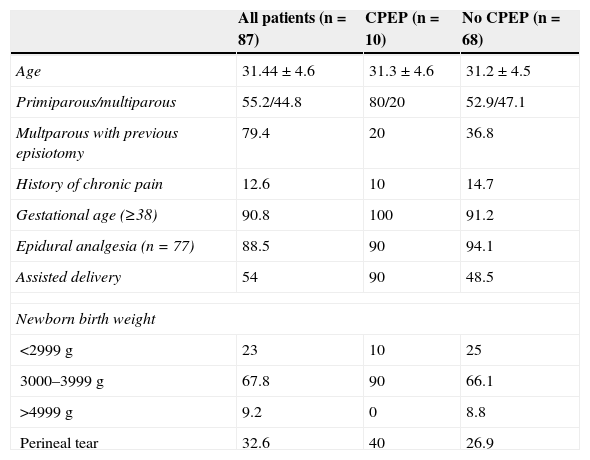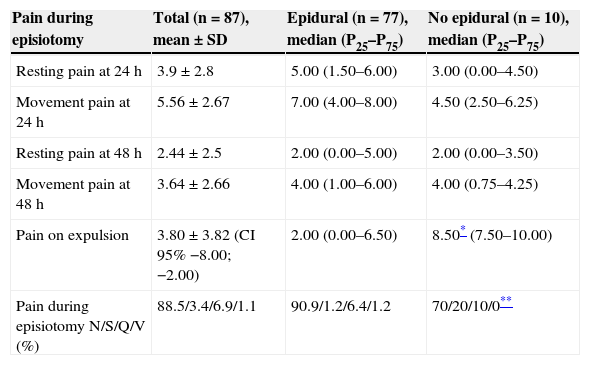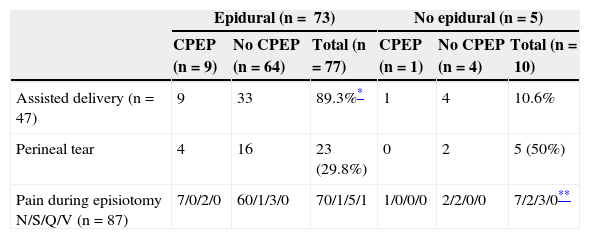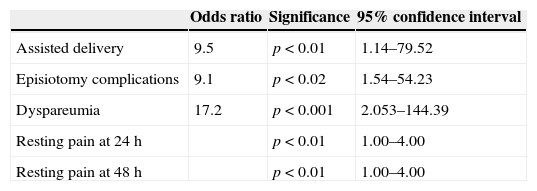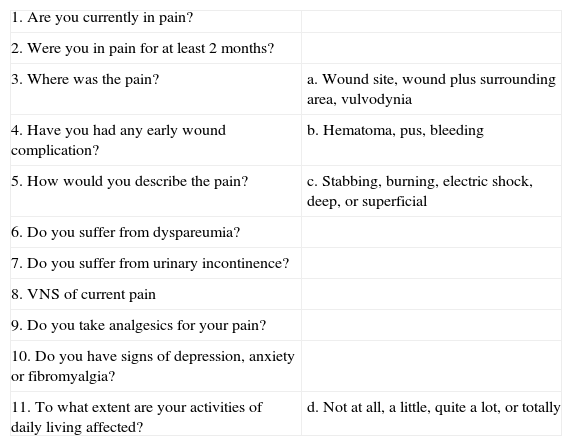To analyze the incidence of chronic pain 5 months after episiotomy, as well as potential prognostic factors.
MethodsA prospective cohort observational study was conducted on pregnant women age≥18 years who had undergone an episiotomy. The presence of pain was evaluated in the area of episiotomy at 24 and 48h of delivery using a structured face-to-face questionnaire, and by telephone questionnaire at 5 months. The primary endpoint was the presence of persistent pain at 5 months. A record was made of the presence of pain at delivery, and its intensity, the presence or absence of epidural analgesia, instrumental delivery, perineal tear, and pain when episiotomy was performed, as well as the presence of dyspareunia and urinary incontinence at 5 months post-episiotomy.
ResultsA total of 87 parturient patients were included, of whom 78 completed the study. Of the patients who completed the study, 12.8% reported chronic episiotomy pain. Epidural analgesia was associated with a higher incidence of instrumental delivery and less pain at the time of episiotomy and expulsion (P<.0005, P<.02, and P<.01, respectively). Chronic pain is associated with operative delivery (P<.017), and with the presence of pain at rest at 24 and 48h (P<.01), of wound complications (P<.026), and of dyspareunia (P<.001).
ConclusionAn incidence of 12.8% of women developing chronic pain after delivery with episiotomy suggests a health problem. More studies are needed to confirm our results.
Analizar la incidencia de dolor crónico a los 5 meses de la realización de episiotomía y los posibles factores pronósticos asociados.
MétodosEstudio observacional de cohortes prospectivo en parturientas a las que se les realizó episiotomía. Se incluyeron las pacientes con edad igual o superior a 18 años. Se evaluó la presencia de dolor en el área de la episiotomía a las 24 y 48h del parto mediante encuesta presencial estructurada, y a los 5 meses mediante encuesta telefónica. La variable principal fue la presencia de dolor crónico a los 5 meses. También se investigó la presencia de dolor al expulsivo y su intensidad, la presencia o no de analgesia epidural, parto instrumentado, desgarro perineal, dolor en el momento de la realización de la episiotomía, y la presencia de dispareunia e incontinencia urinaria a los 5 meses posepisiotomía.
ResultadosDe 87 parturientas que se incluyeron, finalizaron el estudio 78. De las pacientes que finalizaron el estudio, el 12,8% refirieron dolor crónico posepisiotomía. La analgesia epidural se relacionó con una mayor incidencia de parto instrumentado y menor dolor en el momento de la episiotomía y del expulsivo (p<0,0005, p<0,02 y p<0,01, respectivamente). El dolor crónico se relacionó con el parto instrumentado (p<0,017), así como con la presencia de dolor en reposo a las 24 y 48h (p<0,01), de complicaciones de la herida (p<0,026) y de dispareunia (p<0,001).
ConclusiónUna incidencia del 12,8% de mujeres con cronificación del dolor tras el parto con episiotomía evidencia un problema de salud. Consideramos que son necesarios más estudios que confirmen nuestros resultados.





